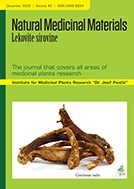Department of Plant Physiology, Institute for Biological Research “Siniša Stankovic”-National Institute of Republic of Serbia, University of Belgrade , Belgrade , Serbia
Department of Plant Physiology, Institute for Biological Research “Siniša Stankovic”-National Institute of Republic of Serbia, University of Belgrade , Belgrade , Serbia
Department of Plant Physiology, Institute for Biological Research “Siniša Stankovic”-National Institute of Republic of Serbia, University of Belgrade , Belgrade , Serbia
Department of Plant Physiology, Institute for Biological Research “Siniša Stankovic”-National Institute of Republic of Serbia, University of Belgrade , Belgrade , Serbia
Department of Plant Physiology, Institute for Biological Research “Siniša Stankovic”-National Institute of Republic of Serbia, University of Belgrade , Belgrade , Serbia
Staphylococcus aureus is a human pathogen that causes serious infections with high mortality rates. The antimicrobial activities of eight phenolic compounds (caffeic acid, chlorogenic acid, ferulic acid, morin, quercetin, isoquercitrin, rutin and hesperidin) were evaluated against planktonic and biofilm forming Staphylococcus aureus cells. Their ability to prevent biofilm formation via interference with bacterial cell adhesion and to reduce biomass of 24 h old biofilms has been addressed in this study. The antibacterial activities (MIC/MBC) were demonstrated using the microdilution method and the investigated compounds showed good activity against S. aureus isolates, with MICs in the range 0.05-0.4 mg/mL. Also, they exhibited promising antibiofilm potential in dose depended manner. Among all tested compounds, morin and quercetrin showed the best antibiofilm activity at MIC values. The observed antimicrobial potential of the studied natural products can serve as a starting point towards development of novel plant-based therapeutics for the treatment of common infections such as the ones caused by S. aureus.
This is an open access article distributed under the Creative Commons Attribution License which permits unrestricted use, distribution, and reproduction in any medium, provided the original work is properly cited.

The statements, opinions and data contained in the journal are solely those of the individual authors and contributors and not of the publisher and the editor(s). We stay neutral with regard to jurisdictional claims in published maps and institutional affiliations.